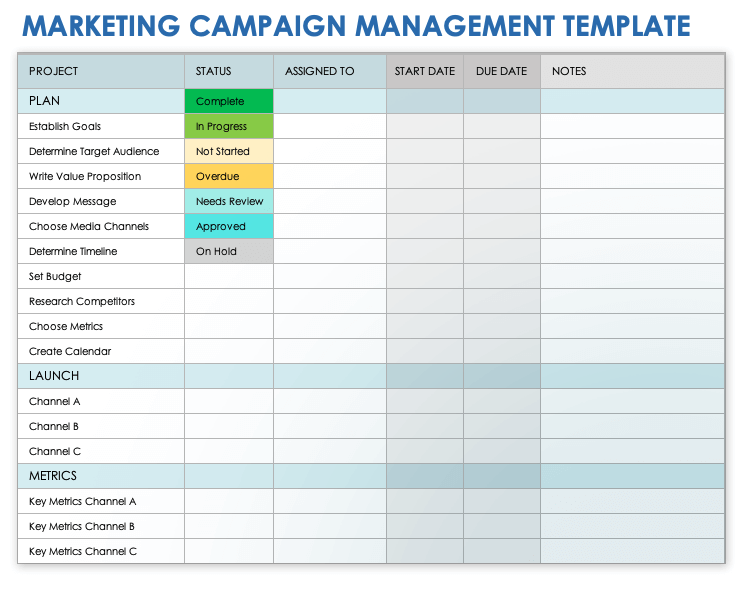How to Create a Marketing Campaign
1. Establish Goals
The first step to creating an effective marketing campaign is setting specific, measurable, achievable, relevant, and time-bound (SMART) goals that align with the company’s overall marketing strategy. Goals establish a clear direction and become the foundation for decision-making. To define these goals, consider what you want the campaign to accomplish. Is the focus on increasing sales, brand awareness, or customer loyalty? Ensure strategic goals by reviewing past marketing campaign metrics to identify areas for improvement, meeting with stakeholders, and conducting an analysis of strengths, weaknesses, opportunities, and threats (SWOT).
For example, an athletic company is launching a new fashionable sports shoe. Here are examples of their marketing campaign SMART goals:
- Expand into five stores within the first three months.
- Secure an athlete endorsement.
- Sell 20,000 shoes in the first quarter.
Pro Tip: Use a SMART goals worksheet to craft strong goals that factor in each element of the acronym.
2. Determine Target Audience
A clearly defined target audience is essential to the success of any marketing campaign. To identify your target audience, analyze who currently uses your product or service, as well as who could potentially use it. Depending on your campaign goals, decide on a specific segment of your audience to target.
It’s crucial to develop a detailed profile of the ideal customer you want this campaign to reach. Define their demographics, including age, gender, location, and average income. Understand their interests, needs, values, fears, and behaviors — including what types of media they consume, where they spend their money, where they spend their time, and what stage of the buyer’s journey they’re in.
One way to gather information on your target audience is by surveying your existing customer base. Use incentives, such as a chance to win a gift card, to motivate customers to complete a short survey. Ask them questions about their demographics, needs, and pain points. This feedback will help you better understand the people who currently use your product, so you can attract new customers.
For the shoe launch example, a target audience might be fashion-forward, 18-to-25-year-old college students who live in urban locations. Potential customers value sports, idolize famous athletes, and spend time on TikTok and shopping at malls with friends.
3. Research Competitors
Research your competitors to learn who buys their product and what details might overlap with your target audience. Evaluate their recent marketing campaigns to determine what channels have been successful and what strategies you can adopt for your campaign. Use their weaknesses to strategically enhance your position and gain a competitive edge.
To develop a successful campaign, it’s crucial to understand the market so you can make your product stand out. Conduct a competitive landscape analysis to evaluate your competitors’ products, features, pricing, marketing content, and sales tactics. Identify gaps to determine where to focus your marketing efforts.
After researching similar offerings from athletic consumer brands such as Adidas, New Balance, and Nike, the athletic company launching the new shoe can better understand the competitive landscape and use these findings to inform its marketing campaign.
4. Write Value Proposition
Write a statement that explains the benefit of your product or service and why a customer should choose it over the competitors. For example, Airbnb defines its value proposition as “to provide travelers with a way to experience the local culture and save money compared to traditional hotel accommodations.”
Use this formula to write your value proposition: We help (X) do (Y) by doing (Z). For example, the value proposition for the athletic company launching the fashion-forward show might be:
We help college athletes achieve peak performance by crafting shoes that provide comfort, support, and durability, empowering them to push their limits and conquer any challenge confidently, all while delivering a shoe that helps them look hip and stylish both on and off the field.

Gayle Kalvert is the founder and CEO at Creo Collective, a full-service B2B marketing agency. “As soon as you have identified your target audience you need to identify how your product or service will benefit them,” she says. “What pain will it solve for them? That is the most important component of any marketing campaign.”
5. Develop Message
An effective marketing campaign message needs to resonate with your target audience and leave a lasting impression. To craft an emotionally engaging campaign message, consider the following elements:
- Brand Identity: Align your message with the company's overall brand voice, tone, and values.
- Storytelling: Articulate a clear narrative about the “why” behind your product or service to build an emotional connection.
- Audience Language: Use words and jargon familiar to your target audience to ensure your message resonates and is easily understood.
- Solution: Explain how your project or service addresses and resolves a specific problem.
- Call to Action (CTA): Specify what you want your audience to do next, such as clicking a link, completing a form, sharing a post, or attending an event.
Taking into consideration all of its findings up to this point, the athletic company might come up with this marketing campaign message:
Ready to dominate the court, crush the track, and own the streets? Our latest kicks blend top-notch performance with next-level style. You’ll stand out on and off the field. These shoes will elevate your game and your look. Lace up, gear up, and show the world what you're made of!

A digital marketing instructor with more than 25 years of experience, Matt Bailey teaches and consults for some of the world's biggest brands. “I look at progression,” he says. “What are we asking people to do? How will they accomplish it? This is where we look at the promise we are making in the message and our calls to action. Then where will they go? To a landing page, website, or another action? We need to define the stages of progression and ensure that they are aligned,” he adds. “I’ve seen too many good campaigns go sideways because of a poor landing page.”
6. Choose Media Channels
Next, you need to decide how you will distribute your campaign message so that it reaches your audience. Choose marketing channels based on where your target audience spends their time — online and offline — as well as how they like to receive information. Keep in mind the costs associated with different channels. Audit your competitors and learn what channels are most successful for them.
Popular marketing channels include:
- Content: Creating original content — whether hosted on a blog, the company website, or other platforms such as YouTube — gives brands additional opportunities to engage their audience.
- Email: Direct marketing via email allows brands to reach customers with personalized content, updates, and newsletters.
- Online Advertising: Targeted ads or sponsored posts are commonly seen on search engines and social media.
- Search Engine Optimization (SEO): Brands can optimize their website content to rank higher in search results.
- Social Media: This includes various platforms, such as Instagram, LinkedIn, Facebook, and TikTok.
- Traditional Media: Television, radio, and print advertisements can reach an offline audience.
The athletic company discovers its target audience spends time on TikTok and plans to tailor marketing efforts to that platform. The TikTok campaign video might showcase college athletes wearing the new kicks in their daily grind, with upbeat music and energetic transitions highlighting the shoe’s sleek design, comfort, and versatility. In the second half of the TikTok video, the same athlete would wear the shoes with a fashionable outfit and spend time out on the town.
Bailey advises that the media and message should align, and the message might need to be customized for different channels. “The message needs to be communicated effectively,” he says. “Many will opt for video, but because each social media platform is different, they will require different takes or edits of the same media.”
Pro Tip: After your campaign launches, if the data shows a specific channel is not performing well, remove it from the campaign. This will allow you to direct more of your budget toward channels that are generating a positive return on investment (ROI).
7. Determine Timeline
A timeline is essential to keep the campaign on track and hold team members accountable. Without a timeline, focus might drift, and the campaign could veer off course before reaching its goal. Create a timeline that specifies the campaign launch date, post-launch checkpoints, and an endpoint. Determine deadlines for deliverables based on your launch plans.
Your timeline should realistically align with your goals and resources. Unrealistic timelines quickly become overwhelming and leave team members feeling defeated. It’s important to factor in potential setbacks, consider upcoming holidays or events, and leave room to extend deadlines if necessary. It’s better to have additional time than be late.
Learn about marketing project management and gain insights from experts.
8. Set Budget
Meet with your finance team to determine which portion of the company’s marketing budget is allocated to the campaign. Analyze data from previous campaigns to determine what resources you’ll require, such as staff salaries, freelancers, website domains, materials, and advertising costs.
It’s important to establish a detailed, realistic budget that aligns with your distribution channels. For example, if you plan to use paid media and hire a website designer, research the costs and decide how much of your budget to allocate to each expense.
Pro Tip: Use one of these marketing budget templates to provide a comprehensive overview of your planned expenditures and help you determine your ROI.
9. Choose Metrics
Choose key performance indicators (KPIs) to quantify the campaign’s success throughout its lifecycle. KPIs should correspond to your goals and the channels you use. For example, if the goal is to grow Instagram followers by 10 percent with influencer partnerships, a great KPI to use is follower growth.
Here is a list of common marketing campaign KPIs:
- Click-Through-Rate (CTR): This metric refers to the ratio of users who click on a specific link to the total number of users who view the page, email, or advertisement.
- Cost per Lead (CPL): Referring to the cost of generating a new prospective customer, CPL is a useful metric for campaigns focused on expanding your customer base.
- Customer Acquisition Cost (CAC): This KPI involves calculating the total cost associated with converting a prospect into a new customer.
- Customer Lifetime Value (CLV): This represents the total revenue generated from a single customer over the course of their relationship with the company.
- Customer Retention Rate (CRR): This measures the percentage of existing customers who remain engaged with the company over a specific time frame.
- Email Open Rate: For email campaigns, it’s important to measure the percentage of recipients who open a specific email.
- Event Attendance: For campaigns centered around in-person or virtual events, it’s crucial to track the number of people who attend.
- Follower Growth: This accounts for the number of new followers gained on a social media account.
- Marketing Qualified Lead (MQL): This metric quantifies potential customers who meet a specific standard of engagement with a brand’s marketing efforts and indicate interest in a product or service.
- Return on Ad Spend (ROAS): This indicates the profit earned for each dollar spent on a marketing ad.
- Return on Investment (ROI): A key metric for evaluating profitability, ROI is the ratio between the net benefits of a campaign and its costs.
- Sales Qualified Lead (SQL): This refers to prospects identified by the sales team as ready for engagement, meaning they have progressed in their buying journey and expressed intention to purchase the product or service.
- Sales Revenue: This refers to the income generated from the sales of a product or service.
- Subscriber Growth: This metric helps you track the rate at which new customers subscribe to your email list, newsletter, or other channels.
- Website Visitors: This counts the number of people who visit a website.
Some KPIs the athletic company would use to measure its marketing campaign for its new shoe could include sales revenue, marketing qualified leads, customer acquisition cost, follower growth, and return on ad spend.
10. Create Calendar
Create a calendar to manage the campaign deliverables — social media posts, email copy, ad materials, etc. — and assign responsibility for each. Your calendar should include a pre-launch phase for preparing materials, a testing phase for gathering data, and an analysis phase so that you can make adjustments before the final launch. Devise a promotional calendar that includes the posting cadence for each channel to ensure all media is released on schedule throughout the campaign’s lifecycle.
Pro Tip: Guarantee your campaign stays on track by using a marketing campaign calendar template to list, organize, and track the campaign deliverables and milestones.
11. Download a Marketing Campaign Plan Template
Once you finalize the elements of your campaign, it’s time to complete the marketing plan document that you can share with your team. Your campaign plan should include both strategic and logistical information, such as who is responsible for each deliverable. Using a template for this task ensures you don’t forget any details and helps you create a consistent format to use in the future.

Download the Marketing Campaign Management Plan Template for Excel
See this collection of marketing campaign templates for more useful tools.
12. Launch Campaign
Launching the campaign means bringing it to life. Prior to the launch date, hold a meeting to ensure the team has a clear understanding of the campaign and its goals. Take this time to answer questions. Share the marketing campaign calendar with team members and stakeholders so that everyone is aware of their responsibilities and the campaign timelines.
Set up processes to monitor the campaign as it runs, and collect data related to your KPIs. Be prepared to adapt your tactics after the initial launch.
13. Analyze Results
Once the campaign ends, it’s time to assess your data. Were goals met on time and within budget? What information do the KPIs reveal? Evaluating your campaign’s performance provides valuable insight for future campaigns. If your message doesn’t land, you might need to refine your target audience or utilize different marketing channels.
Use KPI insights to guide resource allocation and future marketing efforts. If your campaign was a success, analyze the reasons why and carry these takeaways into your next marketing campaign.
You can download and use a marketing dashboard template to see a snapshot of how well your campaign is performing.
Marketing Campaign Starter Kit

Download Marketing Campaign Starter Kit
Get everything you need for creating a marketing campaign in one easy-to-download file with this free marketing campaign starter kit.
In this kit, you’ll find the following:
- A SMART goals worksheet in Microsoft Word to help you define your campaign goals.
- A buyer persona worksheet in Microsoft Word to help you clearly define your target audience.
- A customer journey worksheet in Adobe PDF to guide a detailed analysis of your target audience’s thoughts and actions through the stages of the buyer’s journey.
- A SWOT analysis template in Excel to help you identify opportunities for growth and improvement.
- A competitive analysis template in Microsoft Word for comparing key elements of your competitors and identifying gaps.
- A campaign budget and ROI template in Excel to help you set a detailed budget and track your campaign’s revenue, profit, and ROI.
- A campaign calendar in Excel to enable you to track your campaign’s activities, assign individual responsibilities, and more.
- A campaign report template in Excel to help you track each channel's monthly reach, visits, leads, customers, and conversion rates — and evaluate the data trends over one year.
- A marketing campaign management template to list the project plan activities, assignees, start dates, and due dates.
Best Practices for Planning and Executing Marketing Campaigns
Follow marketing campaign best practices to make strategic decisions, manage risks, and streamline the workload. Apply these best practices to get the most out of your marketing campaign.
- Select Goals That Relate: Your SMART goals should organically connect to each other. For example, if one of your goals is to increase customer retention by 10 percent by Q4 through targeted loyalty programs, additional goals might include expanding loyalty program memberships by 5 percent or introducing tiered loyalty levels by Q3.
- Research Your Target Audience: Don’t assume you know who is interested in your product or service. Survey your current customers, learn which platforms they prioritize, research your competitors, complete buyer personas, and gather insights from your social media accounts and website.
- Have a Clear Call to Action (CTA): Campaigns with complicated or multistep CTAs will confuse potential customers. Direct your target audience to a simple, specific action to ensure a smooth progression through the buyer’s journey. Keep your CTA consistent across all channels and messaging.
- Leverage Effective Tools: Tools such as templates help you stay organized and share valuable information with your team from one, centralized place. Using the right supportive tools saves you time and improves your team’s efficiency.
- Tell a Story: Use your brand’s story to emotionally connect with your audience. A compelling, memorable narrative helps customers understand what sets your brand apart and builds trust, making them more likely to purchase your product or service.
- Be Flexible: If a message or metric is not performing well, change it. Monitor fluctuations in the market so that you can adapt your tactics, manage risk, and improve your campaign’s success rate.
Learn how to manage your marketing campaign with this definitive guide to marketing campaign management.
Examples of Marketing Campaigns
Real-world marketing campaign examples illustrate how efficient resources, collaboration, and organization lead to results. Here are some success stories showing the impact of using the right systems and technologies to manage campaigns.

Deveney Kowalczyk is the Senior Marketing Automation Specialist at PTC, an SaaS company that uses digital technologies to help global manufacturers manage data throughout an entire product lifecycle. The marketing team at PTC relies on technology solutions to create greater impact for its campaigns.
- Challenge: Collaborating with multiple teams and systems without a streamlined process was complex, confusing, and time consuming. The marketing team needed a way to plan and execute campaigns more efficiently, beginning with systematizing their process of initiating marketing activities.
- Solution: Anna Poulakis, Senior Director of Marketing Automation, built a successful intake request process. Poulakis incorporated key data points into dashboards to create a centralized place for project lifecycles and status updates.
- Takeaway: Consolidating different system steps into one, coherent request process leads to a meaningful increase in efficiency. “The time it takes to plan and execute marketing campaigns was reduced by 30 percent,” Kowalczyk says. She also appreciates that information is available in one location and updated in real time. The data can be reviewed year over year, allowing PTC to track crucial marketing trends.

Lou Adams is the Operations Director at Pip Hare Racing. Pip Hare is the eighth woman to have ever completed the Vendee Globe, the round-the-world sailing race.
- Challenge: Pip’s team needed to plan and market her expedition, including organizing media-related projects and figuring out how to share her progress with fans. Some of the team members were volunteers who had never worked together. They needed a platform that allowed them to gather data, share information remotely, and speak the same language.
- Solution: Adams assigned tasks, tracked budgets and timelines, and communicated with the team in real time. The solution even pulled key data from the boat and Pip herself — such as her steps and heart rate — so the team could share updates with fans and show the world what it takes to be a female athlete.
- Takeaway: The tool she uses enables her diverse team to collaborate efficiently and provide real-time visibility into Pip’s amazing journey.
Easily Manage Every Aspect of Marketing Campaigns with Smartsheet
The best marketing teams know the importance of effective campaign management, consistent creative operations, and powerful event logistics -- and Smartsheet helps you deliver on all three so you can be more effective and achieve more. The Smartsheet platform makes it easy to plan, capture, manage, and report on work from anywhere, helping your team be more effective and get more done. Report on key metrics and get real-time visibility into work as it happens with roll-up reports, dashboards, and automated workflows built to keep your team connected and informed. When teams have clarity into the work getting done, there’s no telling how much more they can accomplish in the same amount of time. Try Smartsheet for free, today.